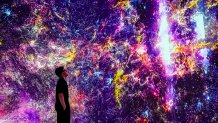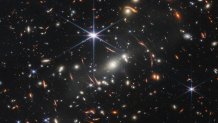
You may need to be an expert in physics or calculus to fully understand how the universe works, but appreciating the magnificence of space is something anyone can do.
And whether it's for the scientific significance or just the sheer beauty, if you're the kind of person who spent days geeking out about the first images released by the James Webb Space Telescope last summer, then you might be just as excited about ARTECHOUSE's new exhibit.
"Beyond the Light," which opened Sept. 15 at the immersive museum's D.C. location, is billed as an "artistic exploration of our unseen universe."
It was created in collaboration with scientists from NASA and physicists from Johns Hopkins University, using information from the Webb and the Hubble space telescopes to make invisible light visible to our eyes.
We've got the news you need to know to start your day. Sign up for the First & 4Most morning newsletter — delivered to your inbox daily. >Sign up here.
The end result is an exhibit that lets you stand inside a nebula — and it even wowed one of the NASA scientists who helped launch the Webb into space.

"I was awed by how incredibly immersive it was," said Mike Menzel, the Webb Mission Systems Engineer.
He's spent over two decades getting the Webb into space and keeping it running, aiming to wow astronomers and the scientific community.
Then, Menzel saw "Beyond the Light" at ARTECHOUSE's New York City location.
The exhibit does justice to all 26-odd years worth of work NASA put into the telescope, he said.
Like previous exhibits at ARTECHOUSE, "Beyond the Light" uses data to create an immersive art display projected onto walls that stand several stories tall.
The upcoming experience tells a story about scientific innovation, and how it's let us stretch all the way "into the furthest reaches of the cosmos," the exhibit webpage reads.
According to Riki Kim, the Executive Creative Director at ARTECHOUSE, the exhibit is a testament to the way light and science can illuminate the beauty that inspires artists.

'If our eyes could see in the infrared'
The collaboration between ARTECHOUSE and NASA's outreach department began years ago, around 2018, according to the museum's founder and chief creative officer, Sandro Kereselidze.
The initial brainstorming sessions between NASA and ARTECHOUSE quickly illuminated light as the heart of the exhibit.
"There is a lot of focus on [the] James Webb Space Telescope having, showing, shining light on, previously, where it was dark," Kim said. "There was something in that. It's a new technology shining light, and being able to see something that wasn't there before."
The long development process meant there was time for improved telescope photos to be taken, for screen resolutions and projection technology to catch up to the detailed data NASA shared, and for that data to be artistically interpreted by ARTECHOUSE for the immersive setting.

The exhibit began in terms of data and not images in part because the James Webb Space Telescope doesn't take photos in the way a typical camera does, Menzel explained.
"It doesn't see in the type of light you and I see in. It doesn't see in the visible," Menzel said. "It sees in a type of light that you and I would sense as heat. It sees in infrared."
The telescope records that infrared light and then sends it back to Earth as data.
"You can picture it as a data stream saying ... each pixel or each location on the image has this much brightness in terms of infrared," Menzel said. "So our data analysts change that to look like the picture that it would appear to be if our eyes could see in the infrared."
That means shorter wavelengths of infrared light are blue, medium wavelengths become green and longer wavelengths become red. It's a very straightforward process, based on numeric values and without artistic interpretation.
NASA shared both fully-formed images and recorded infrared measurements with ARTECHOUSE, according to Kim. The artists took the interpretation to the next level.
The data the art team got "could be anything from just the image source that they have to an actual, like, mathematical data point," Kim said.
One of the artistic challenges for ARTECHOUSE was to fill in gaps that the numbers didn't provide information for, and build out a more immersive 3D experience. The team's goal was to take the familiar two-dimensional images the telescopes captured, then turn them into a cinematic experience you could walk through, Kim said.
"They did a magnificent job in providing what I call an artistic interpretation of what our mission is," and of human innovation in astronomy, Menzel said.
According to Kim, several well-known Webb and Hubble telescope photos are included in "Beyond the Light," including the Cosmic Cliffs, the Crab Nebula and the Pillars of Creation.
The featured photographs in the exhibit include some fan-favorites among the NASA crowd, too.
"My personal favorite image was the very first one that we showed to the White House," Menzel said. "That was the deep field."

That photo was the first to showcase galaxies over 13 billion lightyears away from Earth, Menzel said.
"When I first saw it ... and when I got the technical data on this, the hairs on the back of my neck stood up. I was awed by what I had seen."
The image is similar to many taken by the Hubble Space Telescope, which was launched in 1990 and has made more than 1.5 million observations in the past 33 years. But what the Hubble took 14 days of exposure to capture, the Webb got in just 12 hours -- while seeing further into deep space than ever before.
The shared amazement between NASA and ARTECHOUSE made the achievement even more meaningful.
"I was wowed by the fact that the art community took so much interest in this," Menzel said. "And when they say that the show is immersive, they're not kidding around. It's -- you're right in the middle of the action."
ARTECHOUSE hopes that its artists' interpretation of those images will inspire its visitors.
"I think the idea is really to inspire the 21st-century audience with the latest way to experience the storytelling of the art and science, come together with the help of technology," said Kereselidze.
"We're really trying to aim with this exhibit to inspire the next generation of scientists, the next generation of artists. Because, you know, we all need inspiration to open up our imagination."
How to visit "Beyond the Light"
General admission tickets to "Beyond the Light" are $25 and cost less for children, students, seniors, D.C. residents, military members and first responders. Visitors can save money at those prices by booking online here.
The exhibit is currently programmed to run into November, with the possibility of a longer stay if visitors demonstrate high interest. The building is also home to the XR Bar, which has a changing menu that reflects each exhibit. In this case, it features NASA- and space-themed cocktails.
ARTECHOUSE is located at 1238 Maryland Avenue SW, within walking distance of the National Mall, L'Enfant Plaza and the District Wharf.
Admissions to the exhibit are scheduled for every 30 minutes, with the last session starting at 9 p.m. The museum is open Monday through Sunday from 10 a.m. to 10 p.m.
Want to know what's up for your weekend? Sign up for The Weekend Scene, our newsletter about events, experiences and adventures for you and for your family around the DMV.




